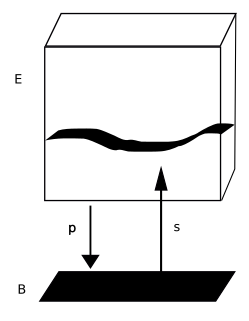In mathematics, especially functional analysis, a Banach algebra, named after Stefan Banach, is an associative algebra A over the real or complex numbers that at the same time is also a Banach space, that is, a normed space that is complete in the metric induced by the norm. The norm is required to satisfy
C∗-algebras are subjects of research in functional analysis, a branch of mathematics. A C*-algebra is a Banach algebra together with an involution satisfying the properties of the adjoint. A particular case is that of a complex algebra A of continuous linear operators on a complex Hilbert space with two additional properties:
In mathematics, specifically category theory, a functor is a map between categories. Functors were first considered in algebraic topology, where algebraic objects are associated to topological spaces, and maps between these algebraic objects are associated to continuous maps between spaces. Nowadays, functors are used throughout modern mathematics to relate various categories. Thus, functors are important in all areas within mathematics to which category theory is applied.

In mathematics, specifically algebraic topology, a covering map is a continuous function from a topological space to a topological space such that each point in has an open neighbourhood evenly covered by . In this case, is called a covering space and the base space of the covering projection. The definition implies that every covering map is a local homeomorphism.

In mathematics, a vector bundle is a topological construction that makes precise the idea of a family of vector spaces parameterized by another space X : to every point x of the space X we associate a vector space V(x) in such a way that these vector spaces fit together to form another space of the same kind as X, which is then called a vector bundle over X.

In mathematics, and particularly topology, a fiber bundle is a space that is locally a product space, but globally may have a different topological structure. Specifically, the similarity between a space and a product space is defined using a continuous surjective map
In topology, a branch of mathematics, a fibration is a generalization of the notion of a fiber bundle. A fiber bundle makes precise the idea of one topological space being "parameterized" by another topological space. A fibration is like a fiber bundle, except that the fibers need not be the same space, nor even homeomorphic; rather, they are just homotopy equivalent. Weak fibrations discard even this equivalence for a more technical property.

In the mathematical field of topology, a section of a fiber bundle is a continuous right inverse of the projection function . In other words, if is a fiber bundle over a base space, :
In mathematics, the Chern–Weil homomorphism is a basic construction in Chern–Weil theory that computes topological invariants of vector bundles and principal bundles on a smooth manifold M in terms of connections and curvature representing classes in the de Rham cohomology rings of M. That is, the theory forms a bridge between the areas of algebraic topology and differential geometry. It was developed in the late 1940s by Shiing-Shen Chern and André Weil, in the wake of proofs of the generalized Gauss–Bonnet theorem. This theory was an important step in the theory of characteristic classes.
In mathematics, specifically in category theory, an exponential object or map object is the categorical generalization of a function space in set theory. Categories with all finite products and exponential objects are called cartesian closed categories. Categories without adjoined products may still have an exponential law.
In mathematics, a Banach bundle is a vector bundle each of whose fibres is a Banach space, i.e. a complete normed vector space, possibly of infinite dimension.
In mathematics, more particularly in complex geometry, algebraic geometry and complex analysis, a positive current is a positive (n-p,n-p)-form over an n-dimensional complex manifold, taking values in distributions.
In mathematics, lifting theory was first introduced by John von Neumann in a pioneering paper from 1931, in which he answered a question raised by Alfréd Haar. The theory was further developed by Dorothy Maharam (1958) and by Alexandra Ionescu Tulcea and Cassius Ionescu Tulcea (1961). Lifting theory was motivated to a large extent by its striking applications. Its development up to 1969 was described in a monograph of the Ionescu Tulceas. Lifting theory continued to develop since then, yielding new results and applications.
In mathematics, convenient vector spaces are locally convex vector spaces satisfying a very mild completeness condition.
This is a glossary of representation theory in mathematics.
The strongest locally convex topological vector space (TVS) topology on , the tensor product of two locally convex TVSs, making the canonical map continuous is called the projective topology or the π-topology. When X ⊗ Y is endowed with this topology then it is denoted by and called the projective tensor product of X and Y.
Nuclear operators are an important class of linear operators introduced by Alexander Grothendieck in his doctoral dissertation. Nuclear operators are intimately tied to the projective tensor product of two topological vector spaces (TVSs).
An integral bilinear form is a bilinear functional that belongs to the continuous dual space of , the injective tensor product of the locally convex topological vector spaces (TVSs) X and Y. An integral linear operator is a continuous linear operator that arises in a canonical way from an integral bilinear form.
In functional analysis, every C*-algebra is isomorphic to a subalgebra of the C*-algebra of bounded linear operators on some Hilbert space H. This article describes the spectral theory of closed normal subalgebras of .
This is a glossary for the terminology in a mathematical field of functional analysis.
























